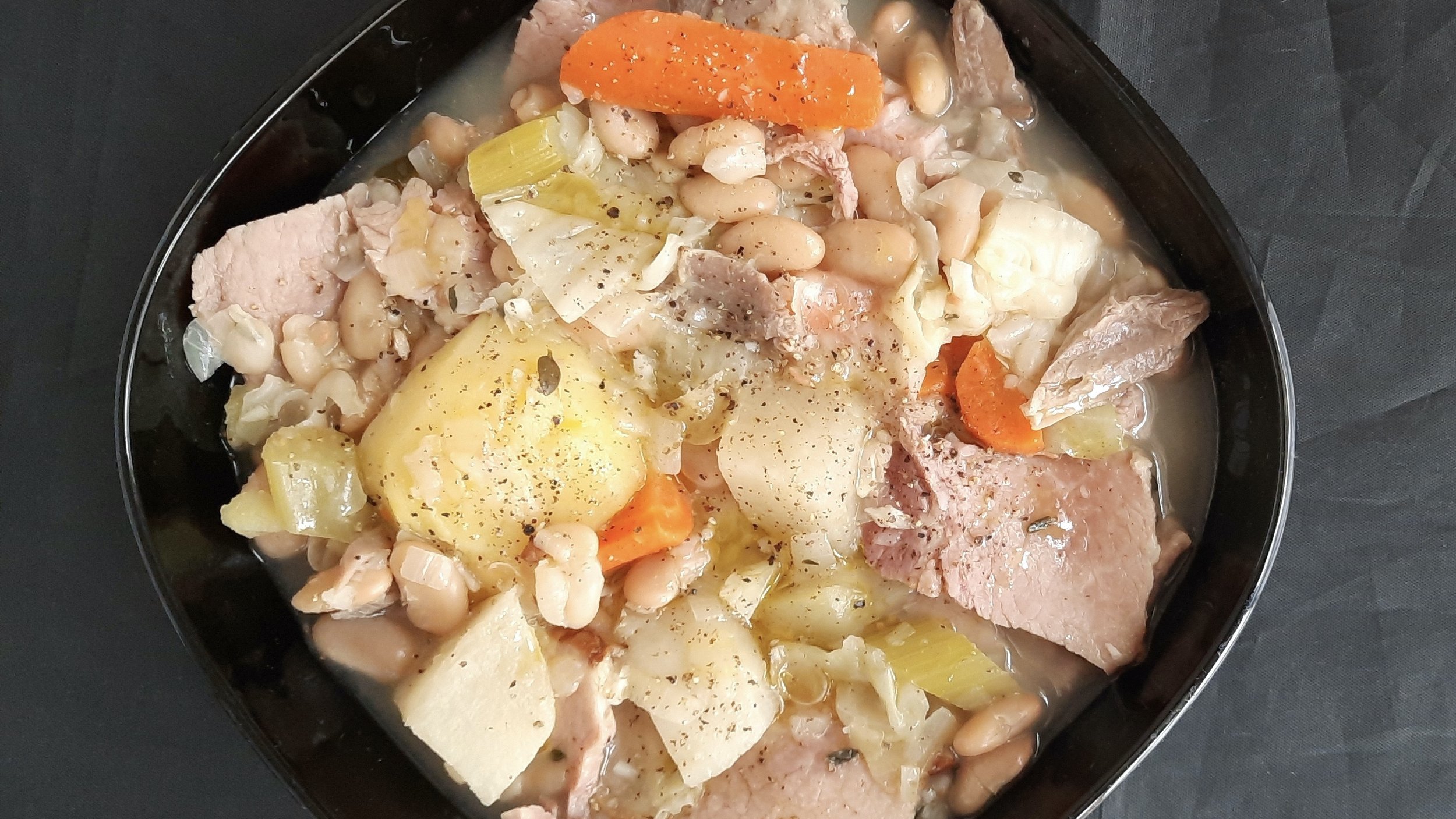GARBURE
Dorothy Parker, the American writer, poet and wit famously defined “eternity” as “two people and a ham.” This was in a day—the early 20th century—when hams were always large, bone-in matters, not the tinned, tear-drop-shaped (or, heavens, the “logs” of pressed scraps and shavings) from the latter half of the century—or today.
If you have any leftover ham from a traditional ham—and who wouldn’t?—use it to make this delicious and very hearty recipe and start your own eternity once again.
Garbure is a thick, vegetable-and-meat stew from far southwest France, served in the Pyrénées, the Basque country, a corner of Gascony and the town of Béarn—birthplace of d’Artagnan, the Musketeer; béarnaise, the sauce; and garbure.
It gets its name from “garb,” a medieval French term for the sheaves of grain often seen in heraldic crests. Thick and chunky, so that it must be eaten with a fork, it recalls the pitchforks used to gather and harvest such grain.
A bowl of Garbure
Garbure des Pyrénées
Adapted from pyrenees-bearnaises.com, the official tourism site for the Gascon town of Béarn in far southwest France. Translated and prepared by Bill St. John.
Ingredients
1 confit of duck leg
1-2 tablespoons duck fat (OK to use extra virgin olive oil)
1 large yellow onion, peeled and diced
3 medium to large cloves garlic, peeled, smashed and minced
1 small (or 1/2 medium) head cabbage, outer leaves removed, cored and cut into thick wedges
2 medium carrots, peeled and cut into 1-inch-sided pieces
1 large turnip, peeled and cut into 12 pieces
2 large yellow or white “waxy” potatoes, 1 peeled, 1 washed but unpeeled and each cut into 8 pieces
2 cups large white beans (such as Tarbais), partially cooked and their cooking water (see note)
1 large rib celery, small diced
1 pound cured or uncured ham scraps (parts of slices, meat off the bone, etc.)
1 teaspoon pepper flakes (Espelette is most traditional, Urfa, Aleppo or Mexican OK too)
3 6-inch sprigs fresh thyme, left intact
Freshly ground black peppercorns
Sea or kosher salt to taste
Directions
In a large pot or Dutch oven, render any outlying fat from the duck leg confit and set it aside. When cool enough to handle (this can be done while the remainder of the recipe cooks), remove and discard the skin and bones from the duck leg and tear the meat into smallish pieces and reserve it.
Add the duck fat or olive oil so that there are 2 tablespoons fat in the pot and cook the onions, over medium-high heat, until translucent, about 8-10 minutes, adding the garlic halfway through in order not to burn it.
Add the pieces of cabbage, carrot, turnip and potato to the pot, stirring. Add the bean’s cooking water and enough additional water to cover everything by at least 1 inch. Bring to a boil, then add the celery, beans, ham, pepper flakes and thyme sprigs.
Lower to a simmer, put the lid on the pot, ajar, and cook at a good simmer or low boil, stirring occasionally, until the beans are cooked through and the other vegetables are tender but not falling apart, 1 hour or more. Taste for and season with salt, if needed. (The ham may have added sufficient salt.) Remove the woody stems of thyme (the leaves will have fallen away into and seasoned the garbure).
At this point, the garbure is best made a day (or more) ahead, left to cool so that the fat rises and congeals (and is skimmed away). But you also may make it day-of, merely skimming any unwanted fat from the surface as it cooks.
Heat well to serve, adding the reserved duck confit shreds so that they warm up well, about 10 minutes before ladling out the garbure into large shallow bowls. Some Béarnais cooks serve the garbure over slices or pieces of stale country or rye bread; still others, with the addition of grated cheese. Others make it with additional or other vegetables.
Everyone tops garbure with a swirl of good extra virgin olive oil.
Note: Cook about 1 cup of the dried beforehand (various methods: soaking overnight; pressure cooker; Instant Pot; in the oven or on the stovetop) to obtain about 2 cups partially cooked beans. Or use the dried beans uncooked and simply increase the garbure’s cooking time.
Wine Pairings and Whys: When bringing a wine to table, of all elements to consider in a dish and its preparation, the most important is how much salt it contains. A bit of salt is no worry (and actually makes any wine taste milder or smoother), but a marked amount of salt makes the wine choice crucial. This soup masquerading as a stew has a fair amount of salt due to the abundance of close-to-the-bone ham. Wines low in acidity or high in alcohol are poor pours in the presence of salt, but any zesty wine, especially one with a tad of sweetness, will win. Such are Argentine Torrontés, Northern Italian Pinot Bianco, Spanish Albariño and, for red wines, something along the lines of a recent-vintage Chianti or a Spanish Crianza Rioja.
